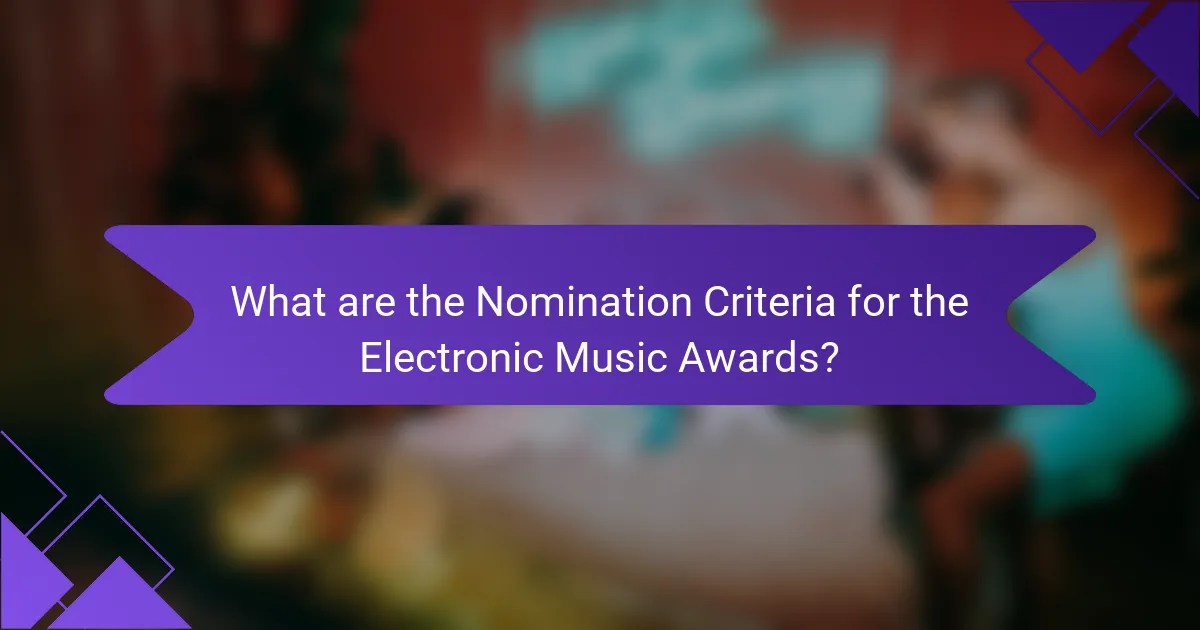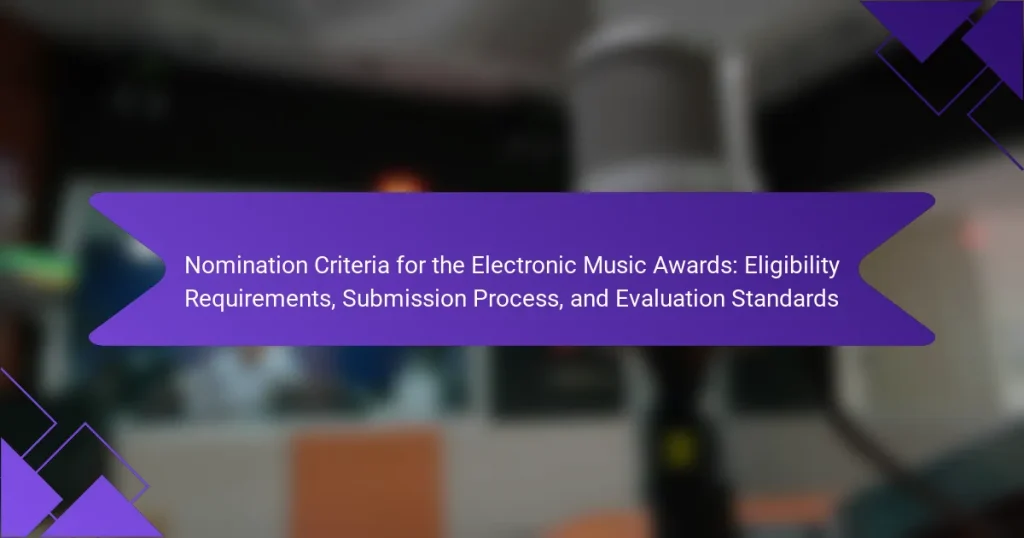The Electronic Music Awards recognize outstanding contributions to the electronic music genre through a structured nomination process. Eligible artists must meet specific criteria, including having released music within the designated eligibility period and demonstrating significant impact or innovation. Nominations are evaluated based on artistic merit, popularity, and critical acclaim, with submissions requiring a complete application form and supporting materials such as music samples. The article outlines the nomination criteria, submission process, and evaluation standards, providing best practices to enhance the likelihood of a successful nomination. Clear guidelines ensure the integrity of the awards and streamline the submission process for artists.

What are the Nomination Criteria for the Electronic Music Awards?
The nomination criteria for the Electronic Music Awards include several key requirements. Eligible artists must have released music within the eligibility period. They must demonstrate significant impact or innovation in the electronic music genre. Nominations are based on artistic merit, popularity, and critical acclaim. Additionally, submissions should include a complete application form and supporting materials. These materials typically consist of music samples and promotional content. The selection process involves a panel of industry experts. This panel evaluates submissions based on predefined standards.
What are the eligibility requirements for nominees?
Nominees must be active participants in the electronic music industry. They should have released music within the eligibility period, typically the past year. Nominees must meet specific genre criteria relevant to the awards. They should also have a minimum number of public performances or releases. Additionally, nominees must comply with any age restrictions set by the award organizers. Proof of eligibility may be required during the submission process. This ensures that all nominees are relevant and recognized within the electronic music community.
Who can be nominated for the Electronic Music Awards?
Artists, producers, and industry professionals in the electronic music genre can be nominated for the Electronic Music Awards. This includes individuals who have made significant contributions to electronic music within the eligibility period. Nominees may include performers, songwriters, and engineers. The awards recognize both established and emerging talent. Specific categories may vary each year, reflecting the evolving landscape of electronic music. Nominations are typically based on achievements and impact in the industry.
What age restrictions apply to nominees?
Nominees must be at least 18 years old to qualify for the Electronic Music Awards. This age requirement ensures that participants have the legal capacity to enter contracts and participate in the awards process. Additionally, age verification may be required during the nomination and voting phases. This policy aligns with standard practices in many award shows to maintain fairness and legal compliance.
What is the submission process for nominations?
The submission process for nominations involves several key steps. First, nominees must complete an online nomination form. This form typically requires detailed information about the nominee and their work. Next, nominees may need to provide supporting materials, such as audio samples or promotional content. These materials help to showcase the nominee’s contributions to electronic music. Once completed, the nomination form and materials should be submitted before the specified deadline. The deadline is usually announced on the awards’ official website. After submission, a review process occurs to evaluate all nominations against established criteria. This process ensures that all nominees meet the eligibility requirements set for the awards.
How do nominees submit their entries?
Nominees submit their entries through an online submission portal. This portal is accessible via the official Electronic Music Awards website. Nominees must fill out a detailed form that includes personal information and project specifics. They are required to upload supporting materials such as audio samples and promotional content. The submission must be completed before the designated deadline. A confirmation email is sent to nominees upon successful submission. This process ensures that all entries are reviewed fairly and efficiently.
What materials are required for a successful submission?
A successful submission for the Electronic Music Awards requires specific materials. These materials typically include a completed nomination form, which provides essential details about the nominee. Additionally, a high-quality audio file of the nominated work is necessary. This audio file should meet the specified format and length requirements set by the awards committee.
Supporting materials may also include a biography of the artist or group, showcasing their achievements and relevance in the electronic music scene. Furthermore, promotional materials, such as press kits or videos, can enhance the submission. Finally, all submissions must comply with the deadlines outlined in the awards guidelines to be considered valid.
What evaluation standards are used for nominations?
Evaluation standards for nominations include artistic merit, innovation, and impact. Artistic merit assesses the quality of the music and performance. Innovation measures originality and creativity in the work. Impact evaluates the influence on the electronic music scene and audience reception. These standards ensure that nominations reflect excellence in the genre. Specific metrics may include critical acclaim, chart performance, and peer recognition.
What criteria do judges consider when evaluating nominees?
Judges consider several criteria when evaluating nominees for the Electronic Music Awards. These criteria include artistic merit, innovation, and cultural impact. Artistic merit assesses the quality and creativity of the nominee’s work. Innovation evaluates how the nominee pushes boundaries in electronic music. Cultural impact measures the nominee’s influence on the genre and its community. Additionally, judges look at the nominee’s consistency in producing quality music over time. They also consider audience engagement and the nominee’s ability to connect with fans. These criteria ensure a comprehensive evaluation of nominees in the electronic music scene.
How is the scoring system structured for nominations?
The scoring system for nominations is structured around a point-based evaluation method. Each nomination is assessed based on specific criteria, including creativity, originality, and technical skill. Judges assign points to each criterion, contributing to an overall score. The total score determines the nominee’s ranking. This structured approach ensures a fair and transparent evaluation process. The use of a point-based system allows for clear differentiation between nominees. Each criterion is weighted to reflect its importance in the overall assessment. This method has been utilized in various award systems to maintain consistency and objectivity.

How do the nomination criteria impact the awards process?
Nomination criteria significantly influence the awards process by establishing the standards for eligibility. These criteria determine which submissions are considered for awards. They ensure that only qualified entries are evaluated, maintaining the awards’ integrity. Clear criteria help streamline the submission process, making it easier for artists to understand requirements. They also guide judges in their evaluation, ensuring consistency in assessment. For instance, specific genre qualifications can narrow the focus to relevant submissions. This focused approach enhances the overall quality of nominations. Ultimately, the criteria shape the awards landscape by defining what excellence looks like in electronic music.
Why are eligibility requirements important for the nomination process?
Eligibility requirements are crucial for the nomination process because they establish clear standards for candidates. These standards ensure that only qualified individuals are considered for recognition. By defining eligibility, the process promotes fairness and transparency. It helps to maintain the integrity of the awards. Specific criteria can include factors such as experience, achievements, and contributions to the electronic music industry. This specificity allows for a more focused evaluation of nominees. Additionally, eligibility requirements help to streamline the nomination process. They reduce ambiguity and set expectations for all participants involved.
What role does the submission process play in ensuring fairness?
The submission process plays a crucial role in ensuring fairness in the nomination criteria for the Electronic Music Awards. It standardizes how entries are received and evaluated. This process allows all nominees to present their work under the same conditions. Equal access to submission guidelines fosters transparency. Clear criteria prevent bias in the selection of nominees. Additionally, a structured timeline ensures timely evaluations. The submission process also enables judges to focus on merit rather than personal connections. Overall, it creates an equitable environment for all participants.

What are the best practices for a successful nomination?
To achieve a successful nomination, it is essential to follow specific best practices. First, ensure that you meet all eligibility requirements laid out by the Electronic Music Awards. This includes adhering to submission deadlines and providing all required materials. Next, craft a compelling nomination statement that highlights the nominee’s unique contributions to electronic music. Use clear and concise language to convey the nominee’s achievements. Additionally, gather supporting documentation, such as press coverage or testimonials, to strengthen the nomination. It is also crucial to tailor the nomination to align with the award’s evaluation standards. Finally, seek feedback from peers before submission to refine the nomination further. Following these practices increases the likelihood of a successful nomination.
How can nominees enhance their chances of being selected?
Nominees can enhance their chances of being selected by ensuring their submissions meet all eligibility requirements. They should provide high-quality audio samples that showcase their best work. Engaging with the electronic music community can also increase visibility. Building a strong online presence through social media can attract more attention. Collaborating with other artists can lead to broader recognition. Consistently releasing new material keeps nominees relevant in the industry. Participating in live performances can demonstrate their talent and commitment. Following submission guidelines meticulously is crucial for consideration.
What common mistakes should nominees avoid during submission?
Nominees should avoid incomplete submissions. Submitting missing documents can lead to disqualification. Additionally, nominees often overlook the submission guidelines. Failing to adhere to format and content requirements is a common error. Miscommunication about eligibility can also occur. Nominees must ensure they meet all criteria before applying. Lastly, submitting late can disqualify entries. Timeliness is crucial in the submission process.
How can nominees effectively present their work to judges?
Nominees can effectively present their work to judges by clearly showcasing their unique attributes. They should start by providing a concise overview of their project. This includes defining the concept and its relevance in the electronic music landscape. Visual aids, such as videos or slideshows, can enhance understanding and engagement. Demonstrating the creative process is essential; nominees should highlight key milestones and decisions made during production.
Additionally, nominees should articulate the impact of their work on the audience and the genre. Sharing feedback from listeners or industry professionals can provide validation. Finally, practicing the presentation ensures confidence and clarity. Effective communication and preparation can significantly influence judges’ perceptions.
What resources are available for potential nominees?
Potential nominees have access to various resources for the nomination process. These resources include official guidelines detailing eligibility criteria and submission requirements. Additionally, there are FAQs and support contacts available for inquiries. Online platforms may provide tutorials or webinars on the submission process. Social media channels often feature updates and tips for nominees. Networking events can also serve as resources for sharing experiences and gaining insights. These resources ensure nominees are well-informed and prepared for the nomination.
The main entity of this article is the Electronic Music Awards, which recognizes outstanding contributions within the electronic music genre. Key information covered includes the nomination criteria, which outline eligibility requirements such as active participation in the industry, age restrictions, and the submission process involving detailed application forms and supporting materials. The evaluation standards for nominations are also discussed, focusing on artistic merit, innovation, and cultural impact. Additionally, best practices for successful nominations and common mistakes to avoid are highlighted to assist potential nominees in navigating the awards process effectively.


